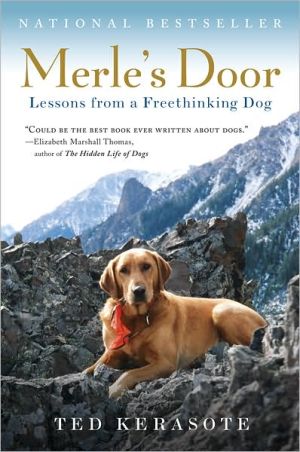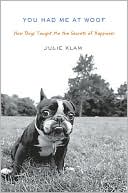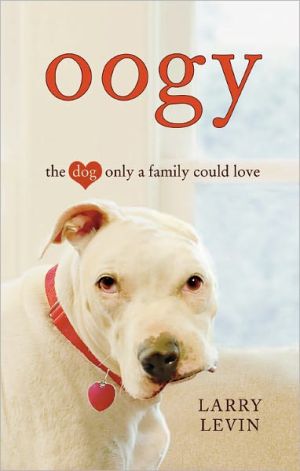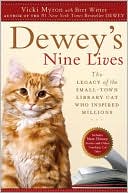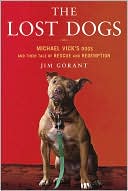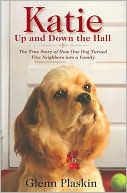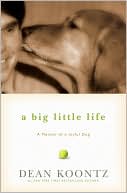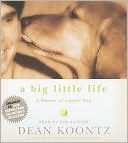Merle's Door: Lessons from a Freethinking Dog
Now including a wonderful new photo insert chronicling Merle’s life, this national bestseller explores the relationship between humans and dogs. How would dogs live if they were free? Would they stay with their human friends?\ Merle and Ted found each other in the Utah desert—Merle was living wild and Ted was looking for a pup to keep him company. As their bond grew, Ted taught Merle how to live around wildlife, and Merle taught Ted about the benefits of letting a dog make his own...
Search in google:
A deeply touching portrait of a remarkable animal, Kerasote explores the issues that all animals and their human companions face as their lives intertwine. He also presents the latest research into animal behavior as well as the origins and evolution of human-dog interaction. Unabridged. 10 CDs. Publishers Weekly Kerasote, winner of the National Outdoor Book Award, draws on inspirational experiences with his beloved canine companion, Merle, and extensive research in animal behavior to advance the notion that living in harmony with our dogs requires us to embrace-rather than suppress-their natural instincts. Patrick Lawlor delivers an animated performance, both literally and figuratively. His renderings of Merle's incessant pants of enthusiasm evoke the essence of canine loyalty. Lawlor successfully navigates the potentially tricky terrain of the book's anthropomorphism. He gives voice to Kerasote's human interpretations of Merle's expressions and behaviors in a manner that manages to preserve a healthy measure of mystery and wonder. Lawlor does slightly over-reach with regard to his performance of relatively extraneous human dialogue, especially some of the ethnic accents of experts that Kerasote quotes in the text. While not all pet owners may be able to grant the degree of freedom that Kerasote afforded Merle, this heartwarming story will still manage to enlighten and entertain fans of four-legged memoirs. Simultaneous release with the Harcourt hardcover (Reviews, Apr. 9). (Aug.)Copyright 2007 Reed Business Information
chapter 1 \ From the Wild\ \ He came out of the night, appearing suddenly in my headlights, a big, golden dog, panting, his front paws tapping the ground in an anxious little dance. Behind him, tall cottonwoods in their April bloom. Behind the grove, the San Juan River, moving quickly, dark and swollen with spring melt.\ It was nearly midnight, and we were looking for a place to throw down our sleeping bags before starting our river trip in the morning. Next to me in the cab of the pickup sat Benj Sinclair, at his feet a midden of road-food wrappers smeared with the scent of corn dogs, onion rings, and burritos. Round-cheeked, Buddha-bellied, thirty-nine years old, Benj had spent his early years in the Peace Corps, in West Africa, and had developed a stomach that could digest anything. Behind him in the jump seat was Kim Reynolds, an Outward Bound instructor from Colorado known for her grace in a kayak and her long braid of brunette hair, which held the faint odor of a healthy, thirty-two-year-old woman who had sweated in the desert and hadn’t used deodorant. Like Benj and me, she had eaten a dinner of pizza in Moab, Utah, a hundred miles up the road where we’d met her. Like us, she gave off the scents of garlic, onions, tomato sauce, basil, oregano, and anchovies.\ In the car that pulled up next to us were Pam Weiss and Bennett Austin. They had driven from Jackson Hole, Wyoming, to Moab in their own car, helped us rig the raft and shop for supplies, joined us for pizza, and, like us, wore neither perfume nor cologne. Pam was thirty-six, an Olympic ski racer, and Bennett, twenty-five, was trying to keep up with her. They had recently fallen in love and exuded a mixture of endorphins and pheromones.\ People almost never describe other people in these terms—noting first their smells—for we’re primarily visual creatures and rely on our eyes for information. By contrast, the only really important sense-key for the big, golden dog, doing his little dance in the headlights, was our olfactory signatures, wafting to him as we opened the doors.\ It was for this reason—smell—that I think he trotted directly to my door, leaned his head forward cautiously, and sniffed at my bare thigh. What mix of aromas went up his long snout at that very first moment of our meeting? What atavistic memories, what possibilities were triggered in his canine worldview as he untangled the mysteries of my sweat? The big dog—now appearing reddish in the interior light of the truck and without a collar—took another reflective breath and studied me with excited consideration. Might it have been what I ate, and the subtle residue it left in my pores, that made him so interested in me? It was the only thing I could see (note my human use of “see” even while describing an olfactory phenomenon) that differentiated me from my friends. Like them, I skied, biked, and climbed, and was single. I had just turned forty-one, a compact man with chestnut hair and bright brown eyes. But when I ate meat, it was that of wild animals, not domestic ones—mostly elk and antelope along with the occasional grouse, duck, goose, and trout mixed in.\ Was it their metabolized essence that intrigued him—some whiff of what our Paleolithic ancestors had shared? Smell is our oldest sense. It was the olfactory tissue at the top of our primeval nerve cords that evolved into our cerebral hemispheres, where thought is lodged. Perhaps the dog—a being who lived by his nose—knew a lot more about our connection than I could possibly imagine.\ His deep brown eyes looked at me with luminous appreciation and said, “You need a dog, and I’m it.”\ Unsettled by his uncanny read of me—I had been looking for a dog for over a year—I gave him a cordial pat and replied, “Good dog.”\ His tail beat steadily, and he didn’t move, his eyes still saying, “You need a dog.”\ As we got out of the cars and began to unpack our gear, I lost track of him. There was his head, now a tail, there a rufous flank moving among bare legs and sandals.\ I threw my pad and bag down on the sand under a cottonwood, slipped into its silky warmth, turned over, and found him digging a nest by my side. Industriously, he scooped out the sand with his front paws, casting it between his hind legs before turning, turning, turning, and settling to face me. In the starlight, I could see one brow go up, the other down.\ Of course, “brows” isn’t really the correct term, since dogs sweat only through their paws and have no need of brows to keep perspiration out of their eyes, as we do. Yet, certain breeds of dogs have darker hair over their eyes, what might be called “brow markings,” and he had them.\ The Hidatsa, a Native American tribe of the northern Great Plains, believe that these sorts of dogs, whom they call “Four-Eyes,” are especially gentle and have magical powers. Stanley Coren, the astute canine psychologist from the University of British Columbia, has also noted that these “four-eyed” dogs obtained their reputation for psychic powers “because their expressions were easier to read than those of other dogs. The contrasting-colored spots make the movements of the muscles over the eye much more visible.”\ In the starlight, the dog lying next to me raised one brow while lowering the other, implying curiosity mixed with concern over whether I’d let him stay.\ “Night,” I said, giving him a pat. Then I closed my eyes.\ \ When I opened them in the morning, he was still curled in his nest, looking directly at me.\ “Hey,” I said.\ Up went one brow, down went the other.\ “I am yours,” his eyes said.\ I let out a breath, unprepared for how his sweet, faintly hound-dog face—going from happiness to concern—left a cut under my heart. I had been looking at litters of Samoyeds, balls of white fur with bright black mischievous eyes. The perfect breed for a winter person like myself, I thought. But I couldn’t quite make myself bring one home. I had also seriously considered Labrador Retrievers, taken by their exuberant personalities and knowing that such a robust, energetic dog could easily share my life in the outdoors as well as be the bird dog I believed I wanted. But no Lab pup had given me that undeniable heart tug that said, “We are a team.”\ The right brow of the dog lying by me went down as he held my eye. His left brow went up, implying, “You delayed with good reason.”\ “Maybe,” I said, feeling my desire for a pedigree dog giving way. “Maybe,” I said once more to the dog whose eyes coasted across mine, returned, and lingered. He did have the looks of a reddish yellow Lab, I thought, at least from certain angles.\ At the sound of my voice, he levered his head under my arm and brought his nose close to mine. Surprisingly, he didn’t try to lick me in that effusive gesture that many dogs use with someone they perceive as dominant to them, whether it be a person or another dog—a relic, some believe, of young wolves soliciting food from their parents and other adult wolves. The adults, not having hands to carry provisions, bring back meat in their stomachs. The pups lick their mouths, and the adults regurgitate the partly digested meat. Pups who eventually become alphas abandon subordinate licking. Lower-ranking wolves continue to display the behavior to higher-ranking wolves, as do a great many domestic dogs to people. This dog’s self-possession gave me pause. Was he not licking me because he considered us peers? Or did my body language—both of us being at the same level—allow him to feel somewhat of an equal? He circumspectly smelled my breath, and I, in turn, smelled his. His smelled sweet.\ Whatever he smelled on mine, he liked it. “I am yours,” his eyes said again.\ Disconcerted by his certainty about me, I got up and moved off. I didn’t want to abandon my plans for finding a pup who was only six to eight weeks old and whom I could shape to my liking. The dog read my energy and didn’t follow me. Instead, he went to the others, greeting them with a wagging tail and wide laughs of his toothy mouth. “Good morning, good morning, did you sleep well?” he seemed to be saying.\ But as I organized my gear, I couldn’t keep my eyes from him. Despite his ribs showing, he appeared fit and strong, and looked like he had been living outside for quite a while, his hair matted with sprigs of grass and twigs. He was maybe fifty-five pounds, not filled out yet, his fox-colored fur hanging in loose folds, waiting for the adult dog that would be. He had a ridge of darker fur along his spine, short golden plumes on the backs of his legs, and a tuxedo-like bib of raised fur on his chest—just an outline of it—scattered with white flecks. His ears were soft and flannel-like, and hung slightly below the point of his jaw. His nose was lustrous black, he had equally shiny lips, and his teeth gleamed. His tail was large and powerful.\ Copyright © 2007 by Ted Kerasote\ \ All rights reserved. No part of this publication may be reproduced or transmitted in any form or by any means, electronic or mechanical, including photocopy, recording, or any information storage and retrieval system, without permission in writing from the publisher.\ \ Requests for permission to make copies of any part of the work should be submitted online at www.harcourt.com/contact or mailed to the following address: Permissions Department, Harcourt, Inc., 6277 Sea Harbor Drive, Orlando, Florida 32887-6777.
Prologue 11From the Wild 13The First Dog 53The Synaptic Kiss 90In the Genes 119Building the Door 169Growing Into Himself 196Top Dog 250The Gray Cat 290Estrogen Clouds 309At Home in the Arms of the Country 330The Problem of Me 357The Mayor of Kelly 397The Alpha Pair 421White Muzzle 455What Do Dogs Want? 478A Looser Leash 511The First Passing 526Through the Door 549With Many Thanks 609Notes 611
\ From Barnes & NobleBarnes & Noble Discover Great New Writers\ Kerasote wasn't looking for a dog when he was traveling with friends in southwestern Utah. When a large, panting dog emerged from a grove of cottonwoods and trotted toward their campsite, he wasn't prepared for the deep brown eyes that looked into his own and said, "You need a dog and I'm it." Unable to refuse, he named the the Labrador mix Merle and took him home to Wyoming. \ \ Mindful of the freedom he suspects that Merle has enjoyed, Kerasote installs a dog door in his house, allowing Merle to come and go as he pleases, rather than making him a prisoner of his schedule. As the days, seasons, and years pass, Kerasote grows to believe that allowing Merle such liberty to make his own decisions provides a window into the dog's innate intelligence and curiosity -- which Kerasote begins to see as compromised when we constrain animals to live on our terms. Time and again, Merle proves that altering this dynamic is not about control but about trust. \ \ Touching, sad, humorous, and heartfelt, Merle's Door challenges readers to rethink old attitudes and advocates a change in the attitude that has us continually seeking to "train" our pets. An unforgettable look at the enigmatic terrain of our most cherished companions, Merle's Door is a tribute not just to Kerasote's own faithful friend but to dogs everywhere. (Fall 2007 Selection)\ \ \ \ \ Publishers WeeklyKerasote, winner of the National Outdoor Book Award, draws on inspirational experiences with his beloved canine companion, Merle, and extensive research in animal behavior to advance the notion that living in harmony with our dogs requires us to embrace-rather than suppress-their natural instincts. Patrick Lawlor delivers an animated performance, both literally and figuratively. His renderings of Merle's incessant pants of enthusiasm evoke the essence of canine loyalty. Lawlor successfully navigates the potentially tricky terrain of the book's anthropomorphism. He gives voice to Kerasote's human interpretations of Merle's expressions and behaviors in a manner that manages to preserve a healthy measure of mystery and wonder. Lawlor does slightly over-reach with regard to his performance of relatively extraneous human dialogue, especially some of the ethnic accents of experts that Kerasote quotes in the text. While not all pet owners may be able to grant the degree of freedom that Kerasote afforded Merle, this heartwarming story will still manage to enlighten and entertain fans of four-legged memoirs. Simultaneous release with the Harcourt hardcover (Reviews, Apr. 9). (Aug.)\ Copyright 2007 Reed Business Information\ \ \ Booklist (starred review)"In telling Merle''s story, Kerasote also explores the science behind canine behavior and evolution, weaving in research on the human-canine bond and musing on the way dogs see the world. Merle is a true character, yet Merle is also Everydog. An absolute treasure of a book."\ \ \ \ \ \ Library JournalWhen Kerasote and his friends geared up for a boat trip down the San Juan River, he had no idea that a golden-red dog would wander in from the desert and become such an important part of his life. Merle happily joined Kerasote back in Wyoming and became his partner. The dog door that allowed Merle more freedom helped the author learn and understand the complex social life of dogs. Filled with interesting data, this book answers many questions about the domestication of dogs, but the heart of the work is the story of Merle's life in Wyoming. The animal led an idyllic life-with the Grand Tetons as his backyard, he enjoyed the outdoors with Kerasote, and at night he went to sleep to the twilight serenade of coyotes. Patrick Lawlor's narration adds more tail-wagging enthusiasm to this book. This audio version of the successful 2007 hardcover is sure to be popular with all the canine crew and is highly recommended for all public libraries. [Kerasote's Out There: In the Wild in a Wired Age won the National Outdoor Book Award in 2004; Merle's Door is also available as downloadable audio from Audible.-Ed.]\ —Theresa Connors\ \ \ \ \ \ Kirkus ReviewsWilderness writer Kerasote finds his place in the pack with the help of a sociable dog. While camping with friends along the San Juan River, the author was approached by an emaciated Labrador retriever-mix. Merle, as the stray would come to be named, "looked back to the shore, and let out a resigned sigh-I was to learn that he was a great sigher." Then he boarded Kerasote's raft. At journey's end, the author took Merle home to Kelly, Wyo., a half-mile square of private land nestled among Grand Teton National Park, the National Elk Refuge and the Gros Ventre Wilderness. In this rural setting, Merle's obvious desire for independence led Kerasote to install a dog door: "Why should I treat Merle-who had become the best of friends-like an indentured servant, at my beck and call in return for food and lodging simply because he didn't have an opposable thumb with which to manipulate the knob on the front door?" Each day, Merle (soon nicknamed "the Mayor" by neighbors) would exit through the dog door and into the heart of the village, eagerly making his rounds. A careful observer with far-reaching interests, Kerasote reflects on everything from canine decision-making to the possible origins of dog domestication to animal consciousness. In this idyllic corner of the West, the two find love (both human and canine) and friendship, forging a remarkable bond that endures until Merle's death. His passing-and the author's bereavement-are recorded with Kerasote's customary discernment. A thoughtful look at animal intelligence and the human-dog connection. Agent: Russell Galen/Scovil Chichak Galen Literary Agency\ \ \ \ \ Booklist"In telling Merle's story, Kerasote also explores the science behind canine behavior and evolution, weaving in research on the human-canine bond and musing on the way dogs see the world. Merle is a true character, yet Merle is also Everydog. An absolute treasure of a book."\ \ \ \ \ People Magazine Summer Reading Round-Up"[T]his summer's Marley? In his memoir cum training manual, Kerasote waxes poetic about his mutt Merle and provides tips for deepening the dog/human bond."\ \ \ \ \ Author of Dogs Never Lie About Love"Kerasote has created a whole new work of art. Merle's Door is the best, the most utterly compelling translation of dog to human I have ever seen. A terrific book, a superb book, I can't think of a single other book that conveys the love of a human for a dog so well."\ \ \ \ \ Author of The Dog's Mind"Merle’s Door is a love story for grown-ups—an intense reciprocal relationship between a dog and his man, and how we and our dogs genuinely share feelings and emotions."\ \ \ \ \ Author of The Hidden Life of Dogs"It is no exaggeration to say that Merle's Door could be the best book ever written about a dog or dogs—one dog in particular, the magnificent Merle of the title, but also about dogs in general.... It is beautifully written, a real page turner, often funny, always fascinating, and very moving. It's a book you will never forget."\ \ \ \ \ Author of A Natural History of Domesticated Mammals"Beginning with Jock of the Bushveld in 1907, many biographies have been written about wonderful dogs whose lives have crossed the borders between the wild and the tame, but none surpasses Merle's Door. It is a joyous, sad, gripping, and deeply moving testament to the fulfilling relationship that can grow between human and dog."\ \ \ \ \ Author of For the Love of a Dog"This exquisitely written book is sure to be controversial, but it raises important questions that every thoughtful dog owner should consider."\ \ \ \ \ People Magazine"[T]his summer's Marley? In his memoir cum training manual, Kerasote waxes poetic about his mutt Merle and provides tips for deepening the dog/human bond."\ \ \ \ \ Author of How Dogs Think"Reading Merle's Door involves more than just sailing through an engaging biography of a man sharing his life with a rare and free-spirited dog since it contains islands of useful and scientifically sound information about dog behavior as well. To be entertained and educated at the same time time is rare in dog books, which makes this one definitely worth reading."\ \ \ \ \ Author of Animals in Translation"Merle’s Door is a window into the mind of a dog. You will experience his loyalty, fears, and joys and his true inner self. Everybody who loves dogs must read this book."\ \ \ \ \ From the Publisher"Lawlor's breezy, energetic reading fits perfectly with this account of the author's relationship with his pet." —-Booklist\ \
